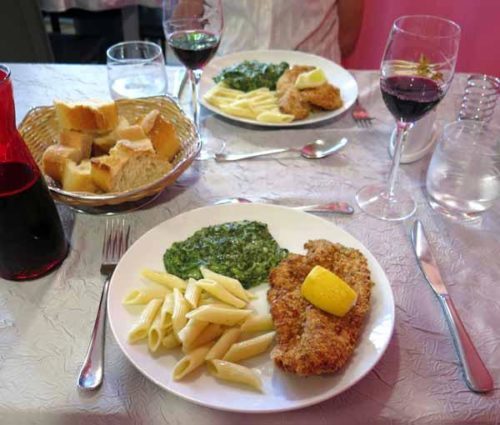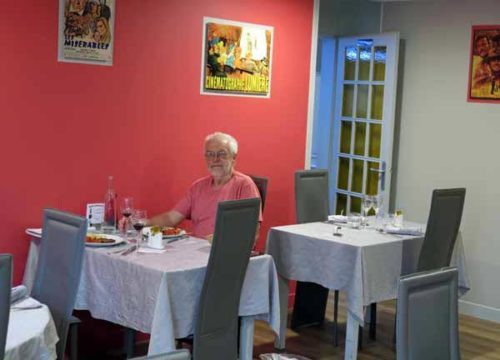
Wednesday, 20 June 2018
Distance 14 km
Duration 3 hours 30 minutes
Ascent 371 m, descent 183 m
Only one of the many small tents around us had vanished by the time we crawled out, and there was still no action from the rest of the aspiring pilgrims when we left at 8 am. We were shocked at their lateness, but then remembered that we had done the same when we first started walking in France, only to be painfully instructed in the advantages of an early start by several heatwaves.
We did not bother with muesli, as it was only an hour’s walk to Polignac, where we were hoping to have a proper French breakfast of pastries and coffee.
The route out of le Puy was familiar from two years ago – through the riverside gardens adjoining the camping ground, across the bridge, then up a steadily rising narrow street to the lip of the great bowl in which the town sat.
Although it was now surrounded by houses, this narrow street had all the attributes of a former main road – it was direct, smoothly graded, enclosed in old stone walls and surmounted at one point by a low archway.

At the top of the rise we looked over into the wide valley beyond, and could make out, through the morning mist, the mighty bulk of Polignac with its ruined château.
It was easy to believe that in former times the dukes of Polignac were masters of the whole district.
As we got nearer, the mist lightened to reveal a cluster of incongruously modern red-and-white houses around the base of the château.
Soon we were climbing up through the houses, on steep grassy lanes, to the foot of the ramparts.
Circling around on a small road, we came to the boulangerie which had been closed when we were here last time, and bought four croissants, which we took to the little bar above the church. This was also open and we sat in the sun to enjoy our breakfast.
It was only yesterday that we had been having a similar breakfast in noisy, busy Paris, but the scene here was utterly different – now we were alone, with a fine old ruin above us, and only birdsong and muted chatter from inside the bar to be heard.
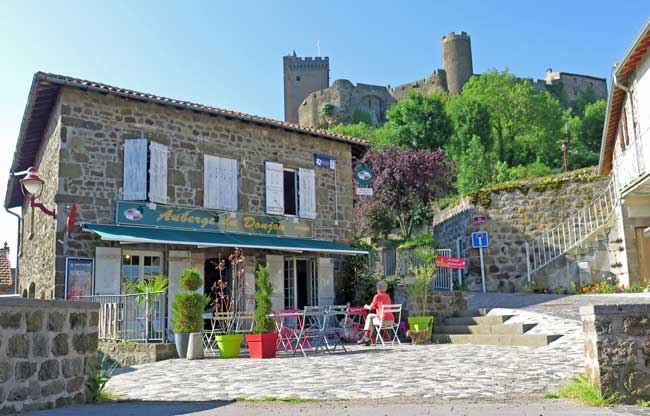
They were two different, but equally delightful occasions, and equally French.
While on the terrace, I took the opportunity to zip off the lower sections of my trousers, revealing ghastly white legs like giant cave-dwelling worms. I hoped that a month of exposure to the light of day would make them less upsetting to look at.

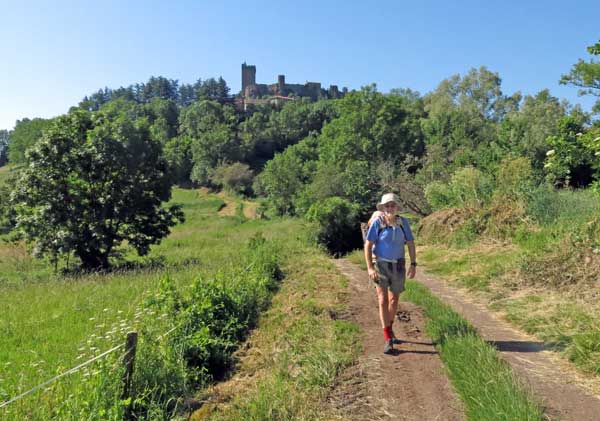
Descending steeply beside the graveyard, we turned off on a wheel track towards the tiny hamlet of Bilhac.
There was evidence of the recent rains on this track – large puddles that we had to skirt around – before we climbed up a wooded hillside and joined what was plainly a traditional main road, with a drystone retaining wall and the remnants of paving underfoot.
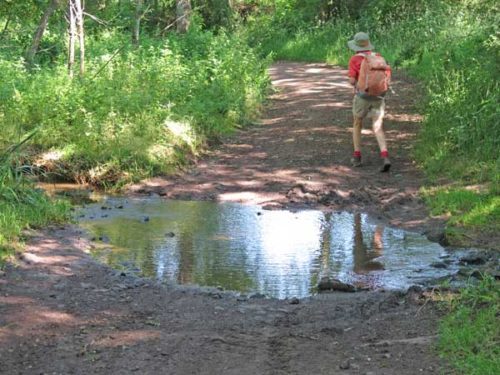
Eventually this old road emerged into cropland, where the farmers were out winnowing their cut hay after the rain, no doubt hoping, as we were, that summer had begun at last.

When this old road was swallowed up by a modern highway (the D906), we found a way through the fields to a smaller road for the last kilometre or so before we entered St-Paulien.
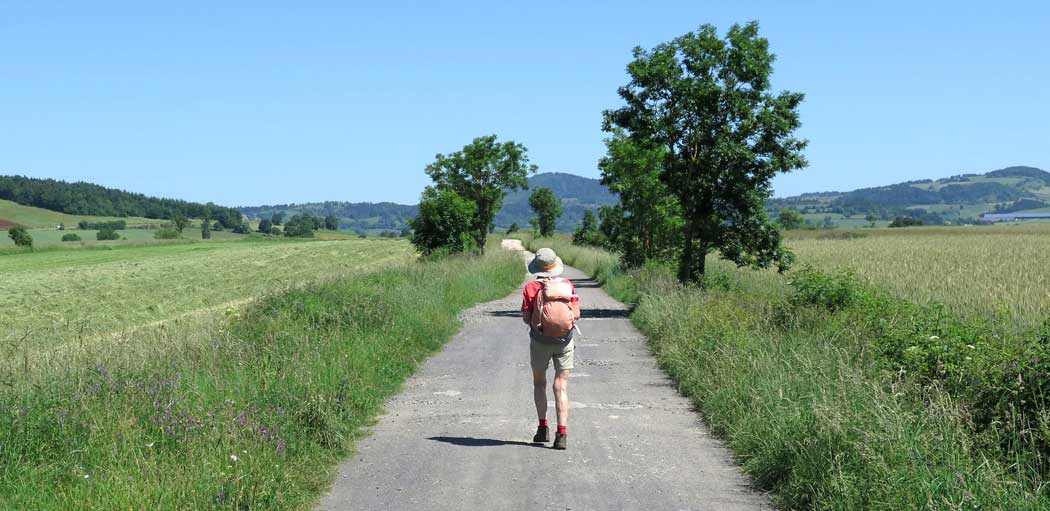
As there was no camping here, we had uncharacteristically booked a room at the hotel, and when we arrived the dining room was full of lunch diners. We had quick showers and joined them.
We intended to eat here again in the evening, so we confined ourselves to a single plate for lunch. The plat du jour was crumbed turkey with spinach and penne, simple and delicious, with a carafe of red wine and a basket of bread to make it a proper French meal.
After that we retired to our room, which looked directly onto the church, and slept for the whole afternoon, only surfacing in time to send off an email to our nearest and dearest, assuring them that we had arrived safely in France.
This was accomplished without rising from our horizontal position on the bed, thanks to our wonderful little iPod, which still has the thrill of novelty after two years.
The dining room in the evening was less lively than at midday, the only other diners being four solitary men at separate tables.
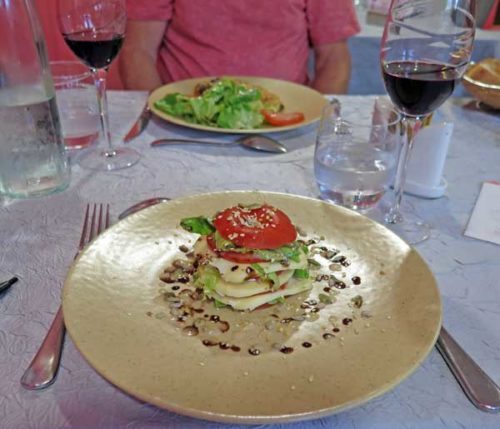
We had the three-course menu for €14, starting with a tomato-mozarella stack for me and a small flaky seafood parcel for Keith.
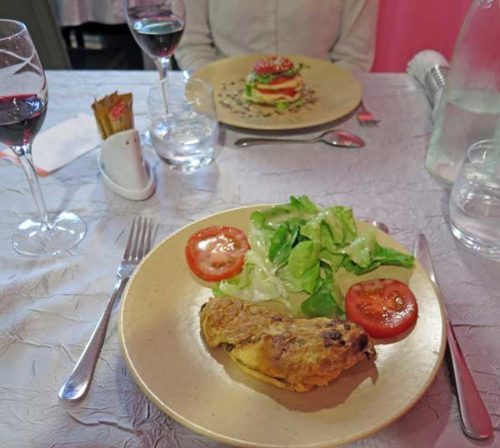
Then we both had boeuf bourguignon, although we were nowhere near Burgundy.
For dessert Keith could not go past crème brûlée. The fieldwork for his Ph.D. research project – “Variations in Crème Brûlée in Regional France” – had been sadly neglected in the past few months. I had coffee, as I lack the gene for the enjoyment of sweet things.
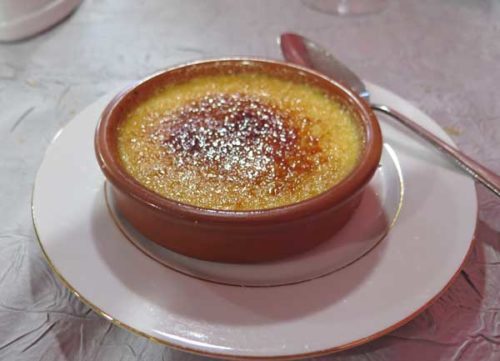
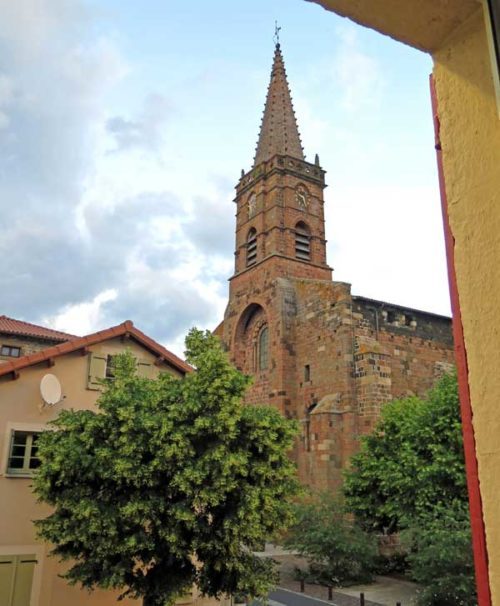
The four solitary men had remained poker-faced during the meal, staring at their phones for the most part, but as one of them rose to go, he gave us a most charming smile and we felt sorry that we had not engaged him in conversation earlier.
We had time before retiring to take a short stroll around the nearby streets, where an outdoor bar behind the church was full of happy chattering people.
This confirmed our opinion, formed in 2016, that St-Paulien was a lovely little town.


